The first steps of hosting
There is a category of people who are attracted by everything that is old and forgotten: grandmother's attic, grandfather's garage, buildings in which life once boiled, and now only fragments of history. And recently, I was curious to look into the earliest stages of the history of web hosting. This article briefly tells in pictures about those pages of history about which representatives of the young generation like me, most likely, know little or know nothing at all.
The era of active development of the World Wide Web begins in 1991, when the restriction on the commercial use of the network was lifted. What it all began with cannot be called a market. And the first were dedicated servers. Then, in the distant 91st, if someone wanted to host their website, they needed their own server. Plus a place to put it, a canal, round the clock food ...
Tracing how the hosting market was formed from 91 to 95-96 years is extremely problematic. For some reason, many articles about the history and evolution of hosting begin almost from the era of dinosaurs and end with a couple of suggestions that after the removal of restrictions, the market began to develop rapidly. In 1995, Angelfire offered free as much as 35 KB of space for user pages, and GeoCities - a whole 1 MB. And about how the market developed further, a lot of interesting told the web archive .
')
Back in 1996, GeoCities was somewhat unusual for a modern webmaster free hosting. He proposed to place his personal "guest pages" in one of the thematic communities. At the end of 1996 there were 29 communities, and by mid-1998 their number reached 40.

That is how in 1996 the service description page with the location directory looked like. Personally, I am amused by the banner on top of the missed episodes of "soap." The advertised site did publish summaries of some TV shows that were broadcast at the time in the United States.
One of the characteristic features of the hosting of those times was the need to strictly save space. On the proposed 35 kilobytes Angelfire many images do not fit. Because free image galleries were popular. Which, moreover, sometimes disappeared and fell into the “people's search”:

In the image you can see a couple of news for 1996 relating to galleries. Including information that one public gallery has stopped working, and those who wish can try to contact the owners and ask for images if they really need to. And the same Angelfire back in 1996 taught users to make backups. However, no matter how accustomed, until the first serious loss of data, most of them do not.

Tripod is another service of those times, providing 2 MB of free space at the dawn of its existence. There was an inscription on the main one: “Tripod is the most stable construction created from the minimum of materials”. Providing site space was not their main service. There were sections “Life and travel”, “Politics and society”, “Work and money” and others. This service, in addition to free hosting, in 1996 began to introduce premium paid hosting, within which, apparently, a fabulous opportunity at that time was offered - 5 MB for only $ 18 in six months.

Next time, uploading about 30 MB of Drupal files, I will feel a certain awe and gratitude for such a rapid development and cheapening of information carriers. And the reduction was really impetuous. In the spring of 1998, the same 5 MB could be obtained free of charge from Angelfire. Already in early 1999, GeoCities offered 11 MB of space for free, and for symbolic $ 4.95 per month it was possible to expand to 25 MB.
In 1998, Tripod and Angelfire were bought by Lycos and became its free hosting services, by 2001 offering 50 MB of space for sites. And in mid-1999, the Yahoo logo appeared on the GeoCities website.
The mentioned Lycos buys Aplus.Net, which was originally engaged in paid hosting, in about 2000–2001. The web archive has kept the company's tariffs for hosting and colocation 15 years ago for posterity.


$ 99.5 for 100 MB! And taking into account inflation, this amount is now equivalent to $ 142.20, for which we can now rent a dedicated server based on E3-1230 for production, and almost enough for a backup server based on Intel Dual-Core. But only 15 years have passed.
Why are there 15. For 3 years they have the same hosting significantly cheaper. In 2001, they had two lines of tariffs - affordable and professional. Remarkably, in each of the lines the volume of disk space was the same, only the set of “buns” differed.
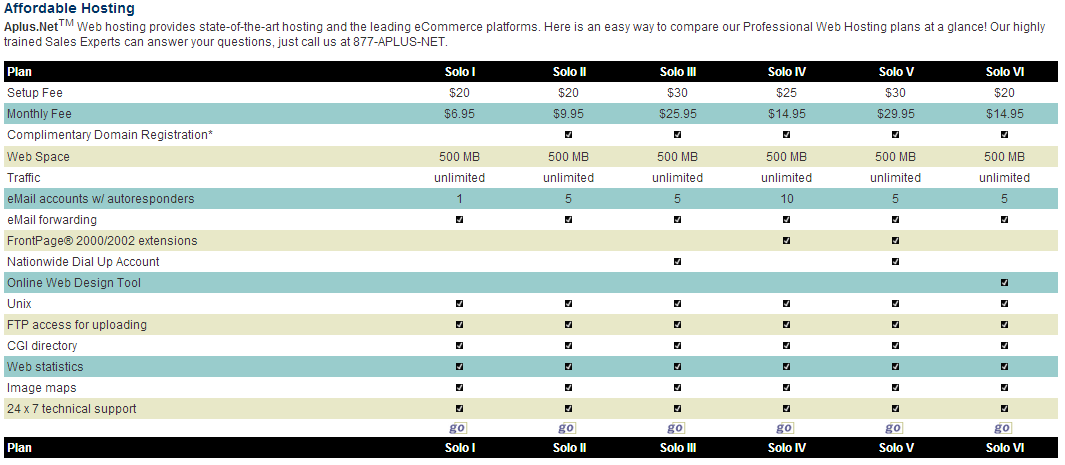
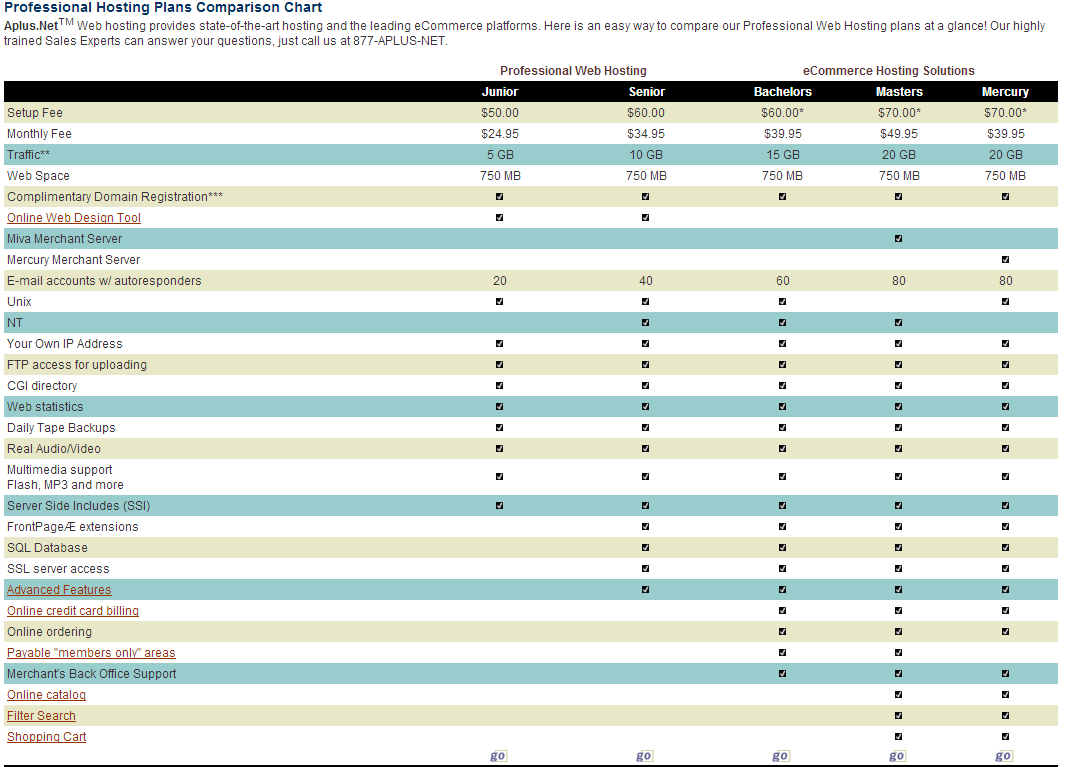
They were engaged at the time and server rental. Here is one of their typical tariff configurations:
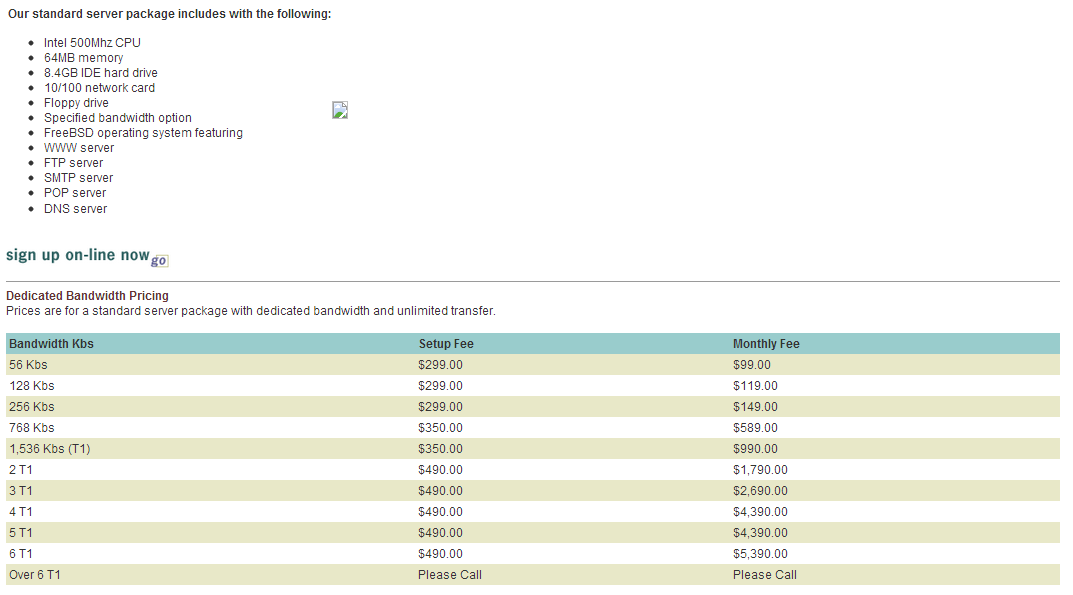
From then until today, perhaps, only tariffs for IP addresses have not changed.

In 2001, Hostmonster first appeared on the horizon. And, to be honest, I am somewhat surprised by the name, given that they offered their clients ... creative websites with photos of their children.

In 2002, Hostgator was founded in the Florida Atlantic University hostel, which initially positioned itself as a full-fledged hosting company. And they had at the start only 3 servers. However, now not every hoster can boast even of this. Tariffs were at a competitive level, but a name like Swamp Croc (Swamp Croc) would have puzzled me a bit.
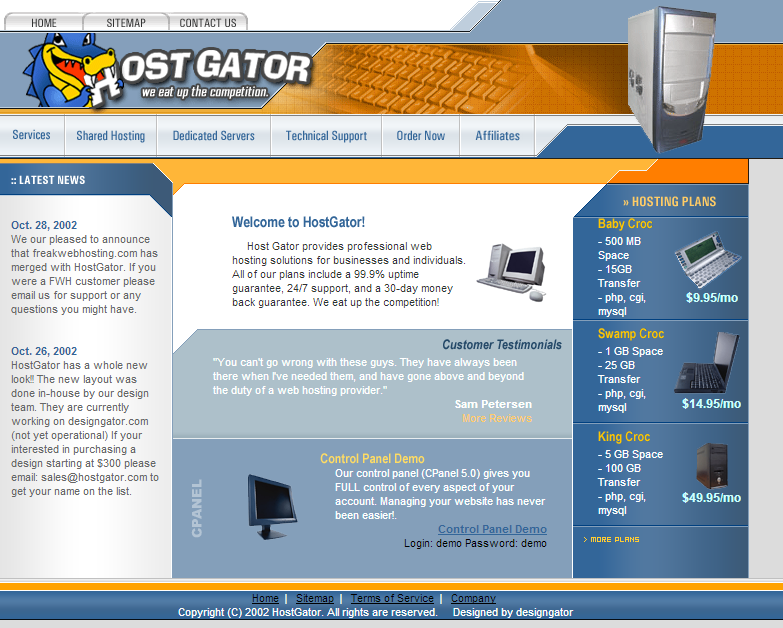
In 1999, the web archive first learns about Agava. She then worked mainly programming, and, judging by the style of presentation of information on the site, consisted of very young and cheerful people. What is worth only their job offer:
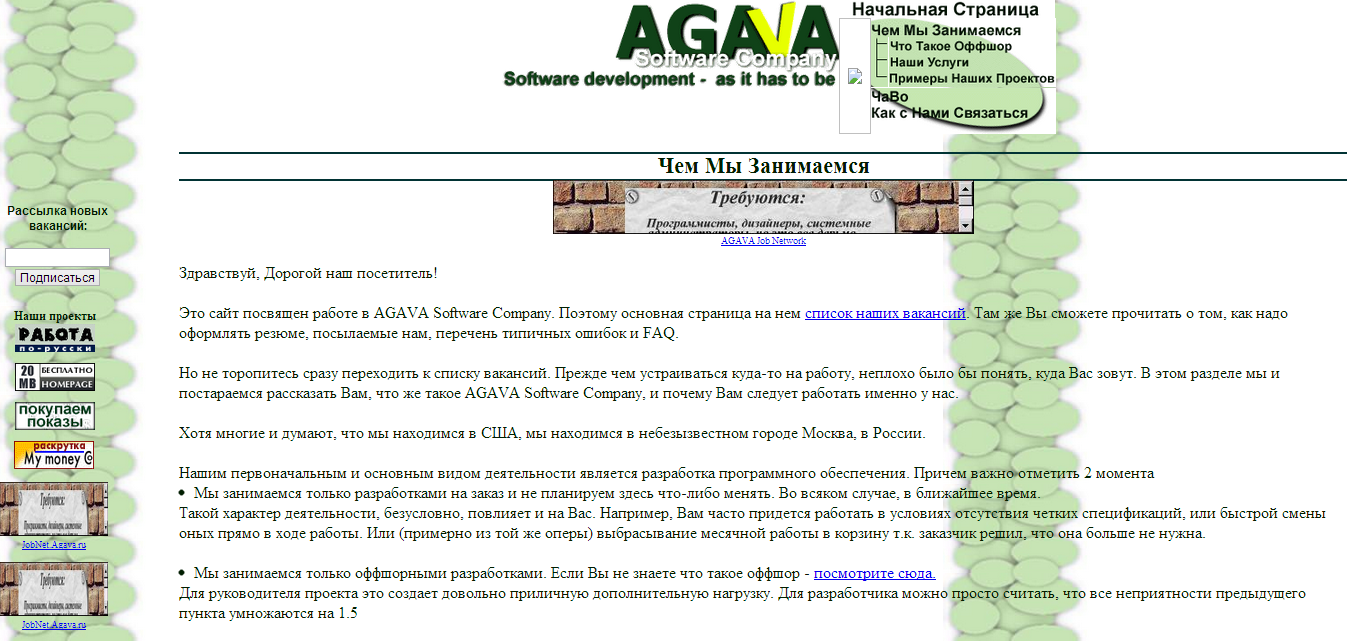
Like foreign colleagues, the company soon after creation opened several services: a job board, a mailing list service, a banner network, and free hosting. But unlike Western counterparts, Agava offered as much disk space as the user can justify. Free hosting worked under the brand holm.ru, and the logo looked accordingly:

By 2002, the company decided that its priority area of activity was a complex of services for creating and hosting websites (including hosting, of course). And I got the impression that the company was a little undercover from taxes.

And when paying by other methods, probably, it is not necessary to take into account and pay taxes.
And one of the undoubted leaders of the free hosting market was, of course, Narod.ru. According to their official data, for 2 months of 2000, the increase in sites amounted to about 40,000.


By the way, Narod.ru proposed for user sites not only a habitat, but also


With the advent of the third millennium, some general development trends have emerged in the hosting market: to make the service easier, more convenient, cheaper, with more opportunities. And here it would be possible to build graphics to reduce the cost of disk space, improve the performance of processors, etc. But they do not smell grandmother's attic and do not cause a smile and affection.
Thank you for reading.
The era of active development of the World Wide Web begins in 1991, when the restriction on the commercial use of the network was lifted. What it all began with cannot be called a market. And the first were dedicated servers. Then, in the distant 91st, if someone wanted to host their website, they needed their own server. Plus a place to put it, a canal, round the clock food ...
Tracing how the hosting market was formed from 91 to 95-96 years is extremely problematic. For some reason, many articles about the history and evolution of hosting begin almost from the era of dinosaurs and end with a couple of suggestions that after the removal of restrictions, the market began to develop rapidly. In 1995, Angelfire offered free as much as 35 KB of space for user pages, and GeoCities - a whole 1 MB. And about how the market developed further, a lot of interesting told the web archive .
')
Back in 1996, GeoCities was somewhat unusual for a modern webmaster free hosting. He proposed to place his personal "guest pages" in one of the thematic communities. At the end of 1996 there were 29 communities, and by mid-1998 their number reached 40.

That is how in 1996 the service description page with the location directory looked like. Personally, I am amused by the banner on top of the missed episodes of "soap." The advertised site did publish summaries of some TV shows that were broadcast at the time in the United States.
One of the characteristic features of the hosting of those times was the need to strictly save space. On the proposed 35 kilobytes Angelfire many images do not fit. Because free image galleries were popular. Which, moreover, sometimes disappeared and fell into the “people's search”:

In the image you can see a couple of news for 1996 relating to galleries. Including information that one public gallery has stopped working, and those who wish can try to contact the owners and ask for images if they really need to. And the same Angelfire back in 1996 taught users to make backups. However, no matter how accustomed, until the first serious loss of data, most of them do not.

Tripod is another service of those times, providing 2 MB of free space at the dawn of its existence. There was an inscription on the main one: “Tripod is the most stable construction created from the minimum of materials”. Providing site space was not their main service. There were sections “Life and travel”, “Politics and society”, “Work and money” and others. This service, in addition to free hosting, in 1996 began to introduce premium paid hosting, within which, apparently, a fabulous opportunity at that time was offered - 5 MB for only $ 18 in six months.

Next time, uploading about 30 MB of Drupal files, I will feel a certain awe and gratitude for such a rapid development and cheapening of information carriers. And the reduction was really impetuous. In the spring of 1998, the same 5 MB could be obtained free of charge from Angelfire. Already in early 1999, GeoCities offered 11 MB of space for free, and for symbolic $ 4.95 per month it was possible to expand to 25 MB.
In 1998, Tripod and Angelfire were bought by Lycos and became its free hosting services, by 2001 offering 50 MB of space for sites. And in mid-1999, the Yahoo logo appeared on the GeoCities website.
The mentioned Lycos buys Aplus.Net, which was originally engaged in paid hosting, in about 2000–2001. The web archive has kept the company's tariffs for hosting and colocation 15 years ago for posterity.


$ 99.5 for 100 MB! And taking into account inflation, this amount is now equivalent to $ 142.20, for which we can now rent a dedicated server based on E3-1230 for production, and almost enough for a backup server based on Intel Dual-Core. But only 15 years have passed.
Why are there 15. For 3 years they have the same hosting significantly cheaper. In 2001, they had two lines of tariffs - affordable and professional. Remarkably, in each of the lines the volume of disk space was the same, only the set of “buns” differed.


They were engaged at the time and server rental. Here is one of their typical tariff configurations:

From then until today, perhaps, only tariffs for IP addresses have not changed.

In 2001, Hostmonster first appeared on the horizon. And, to be honest, I am somewhat surprised by the name, given that they offered their clients ... creative websites with photos of their children.

In 2002, Hostgator was founded in the Florida Atlantic University hostel, which initially positioned itself as a full-fledged hosting company. And they had at the start only 3 servers. However, now not every hoster can boast even of this. Tariffs were at a competitive level, but a name like Swamp Croc (Swamp Croc) would have puzzled me a bit.

Meanwhile in Russia...
In 1999, the web archive first learns about Agava. She then worked mainly programming, and, judging by the style of presentation of information on the site, consisted of very young and cheerful people. What is worth only their job offer:

Like foreign colleagues, the company soon after creation opened several services: a job board, a mailing list service, a banner network, and free hosting. But unlike Western counterparts, Agava offered as much disk space as the user can justify. Free hosting worked under the brand holm.ru, and the logo looked accordingly:

By 2002, the company decided that its priority area of activity was a complex of services for creating and hosting websites (including hosting, of course). And I got the impression that the company was a little undercover from taxes.

And when paying by other methods, probably, it is not necessary to take into account and pay taxes.
And one of the undoubted leaders of the free hosting market was, of course, Narod.ru. According to their official data, for 2 months of 2000, the increase in sites amounted to about 40,000.


By the way, Narod.ru proposed for user sites not only a habitat, but also


New Millennium
With the advent of the third millennium, some general development trends have emerged in the hosting market: to make the service easier, more convenient, cheaper, with more opportunities. And here it would be possible to build graphics to reduce the cost of disk space, improve the performance of processors, etc. But they do not smell grandmother's attic and do not cause a smile and affection.
Thank you for reading.
Source: https://habr.com/ru/post/183784/
All Articles